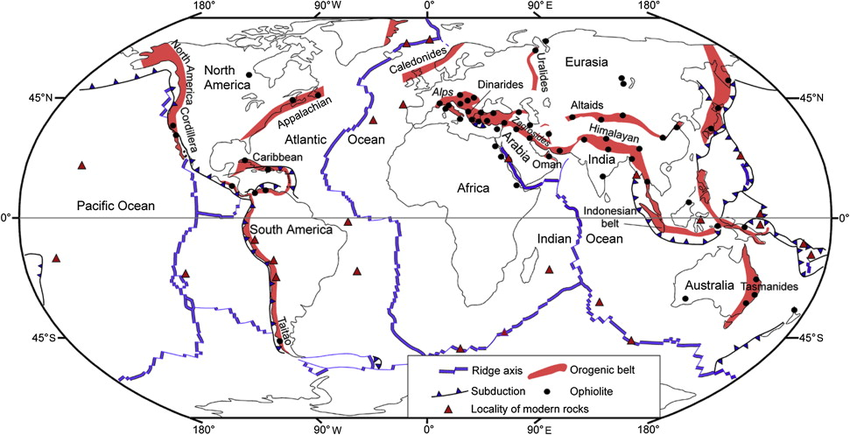
An #ophiolite is a rock with a secret: it tells the story of an ocean that lived and died.
Ophiolites are pieces of crust and mantle that formed at #spreadingcenters below an ocean. Why do we find these rocks (black dots) in mountain belts (red)? 🧵
doi.org/10.1016/j.gsf.…
Ophiolites are pieces of crust and mantle that formed at #spreadingcenters below an ocean. Why do we find these rocks (black dots) in mountain belts (red)? 🧵
doi.org/10.1016/j.gsf.…

The #WilsonCycle describes how tectonic plates break apart, forming an ocean basin that grows around a spreading center. But the oceanic lithosphere is dense, and it eventually breaks and sink into the mantle. #Subduction closes the basin and the plates on either side collide. 

Rocks that form at a #spreadingcenter have a distinctive sequence: sediments on top, then basalts that erupted underwater, then denser rocks crystallized from melted mantle, grading into mantle. You might find this sequence on land (an #ophiolite), but it formed under the ocean. 

#Ophiolites are mostly found in mountain belts: the Alps, Himalaya, Zagros, Andes, Sierras, and more. They tell us that ocean basins used to exist here, but got #subducted away.
Some bits of the oceanic crust were scraped off and left behind.
doi.org/10.1016/j.gr.2…
Some bits of the oceanic crust were scraped off and left behind.
doi.org/10.1016/j.gr.2…

So if you ever see an #ophiolite, think of it as a fossil: not just of a creature, but of a part of the Earth - an ocean basin, a spreading ridge, the whole marine ecosystem that lived above it, and the subduction zone that killed it. /end
gph.is/g/ZdXd6k8?tc=1
gph.is/g/ZdXd6k8?tc=1
• • •
Missing some Tweet in this thread? You can try to
force a refresh









